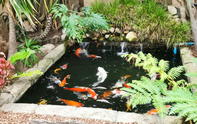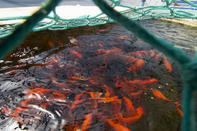Ornamental fish - such as koi, goldfish, and tropical aquarium fish - are beautiful fish kept for display purposes in either glass aquaria or fish ponds.

The production of ornamental fish in South Africa is small and limited to a few breeders, which produce koi, Lake Malawi cichlids, discus fish, killifish and some goldfish. This is mainly done in the Eastern Cape, Mpumalanga and KwaZulu-Natal Provinces.
Production is specialised and competes with high-quality imports from mainly the Far East - about 95% of South Africa’s ornamental fish species are imported.
There is no place in the South African market for cheap, low-quality ornamental fish. Imports are still relatively inexpensive compared to the local costs of production and distribution.
Requirements of Ornamental Fish Production
If South Africa ever considers replacing the import of ornamental fish with its own production, it must adhere to these four requirements, which are what ensure the success of the Far East’s ornamental fish production: It is highly professional. Fish quality is extremely high Marketing is centralised.
Ornamental fish aquaculture is done under warm equatorial conditions that suit the biology and therefore the mass-breeding and rearing of the tropical fish. Quality fish production cannot be done in glass aquaria or even plastic or concrete tanks. High enough quality simply cannot be achieved in such systems.
The Far East production is mostly done in earth ponds, often with green water and abundant natural feeds. Green water production is when fertiliser is added to the water to promote the growth of the fish’s natural food such as daphnia, cyclops and algae. In South Africa, ornamental fish production would demand the use of tunnels in the warmer areas where water can be kept at over 25℃.
The production of goldfish, livebearers and community-tank species such as tetras, labeo ‘sharks’ and catfish do not achieve adequate quality under any alternative design systems. Intense attention to detail and maintaining quality is essential for ornamental fish farming success.
An example of how essential this is is illustrated by a large ornamental fish farm in KwaZulu-Natal that in the 1990s produced a wide range of fish for the South African market. This farm had over 150 tunnel systems, even exporting high-quality guppies to the USA.
The organisation thrived as a centralised business with strong, competent and experienced supervision. Once syndicated out to individual workers, each responsible for one or more tunnel systems, it failed within a year, as attention to detail, quality and even feeding regularity, lapsed.
Challenges in Ornamental Fish Farming in South Africa

The production of ornamental fish in South Africa is limited, as the fish require warm conditions for breeding, but the main population centre, Gauteng, and main market are located in the cool Highveld. In addition, an uninterrupted electricity supply is vitally important and must be taken into account.
There will remain a niche market for specialised species where prices earned and transportation costs justify the production costs of producing these locally by a few expert aquaculture farmers.
Examples are Lake Malawi cichlids, discus fish and other hard-to-breed en masse species. Training for new fish farmers in South Africa is limited to private fish farming experts.
There is limited expertise within government departments and the food-fish farming sector, which would be appropriate for training new ornamental fish farmers.
By Nick James